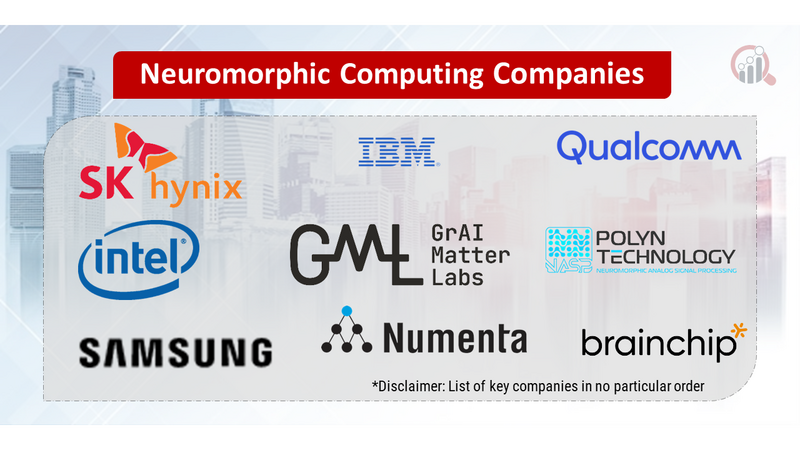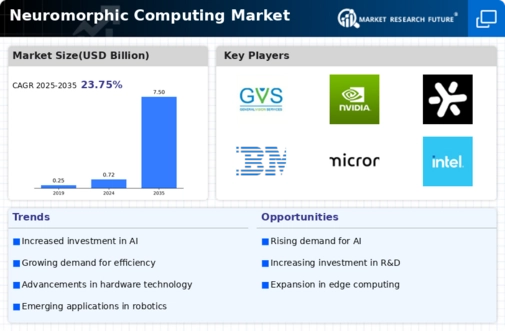Top Industry Leaders in the Neuromorphic Computing Market

Competitive Landscape of Neuromorphic Computing Market:
The neuromorphic computing market is still in its early stages, but it is expected to experience significant growth in the coming years, driven by the increasing demand for artificial intelligence (AI) and machine learning (ML) applications. This market is characterized by a diverse range of players, each with its own unique approach and target market.
Key players:
- Intel Corporation
- Polyn Technology
- IBM Corporation
- Samsung Electronics Co. Ltd.
- SK Hynix Inc.
- GrAI Matter Labs
- Hewlett Packard Development LP
- Qualcomm Incorporated
- BrainChip Holdings Ltd
- Numenta
- General Vision
Strategies adopted by these key players include:
- Developing innovative neuromorphic chip architectures: Companies are investing heavily in research and development to create new neuromorphic chip architectures that offer improved performance and efficiency.
- Building partnerships: Companies are forming partnerships with other players in the ecosystem, such as universities and research institutions, to access expertise and resources.
- Expanding their product portfolio: Companies are expanding their product portfolio to offer a wider range of neuromorphic computing solutions, such as hardware, software, and tools.
- Targeting specific applications: Companies are focusing on specific applications where neuromorphic computing can offer significant advantages, such as healthcare, automotive, and industrial automation.
Factors for market share analysis include:
- Market share by company: This refers to the percentage of the total market revenue that each company holds.
- Market share by product type: This refers to the percentage of the total market revenue generated by each type of neuromorphic computing product.
- Market share by application: This refers to the percentage of the total market revenue generated by each application area.
- Geographic market share: This refers to the percentage of the total market revenue generated in each geographic region.
New and emerging companies in the neuromorphic computing market include:
- Cerebras Systems: A US-based company developing a wafer-scale neuromorphic chip.
- Groq: A US-based company developing neuromorphic chips for artificial intelligence applications.
- SynSense: A US-based company developing neuromorphic chips for medical imaging applications.
- Mythic AI: A US-based company developing neuromorphic chips for edge AI applications.
- Loihi Research Corporation: A US-based company developing neuromorphic chips for research applications.
Current company investment trends in the neuromorphic computing market include:
- Increased investment in research and development: Companies are investing heavily in research and development to create new neuromorphic chip architectures and technologies.
- Partnerships and collaborations: Companies are forming partnerships and collaborations with other players in the ecosystem, such as universities, research institutions, and startups.
- Acquisitions and mergers: Companies are acquiring and merging with other players in the market to gain access to new technologies and markets.
- Focus on specific applications: Companies are focusing on specific applications where neuromorphic computing can offer significant advantages, such as healthcare, automotive, and industrial automation.
Latest Company Updates:
June 2023- BrainChip Holdings Ltd, a renowned name in neuromorphic AI, IP & Lorser Industries Inc, a leader in system level manufacturing & integration have lately unveiled that they will utilize the technology of BrainChip’s Akida to provide neuromorphic computing solutions for the SDR or software defined radio. The joint venture will help in leveraging Lorser’s skill in SDR manufacturing and design and the cutting-edge neuromorphic technology of BrainChip’s for creating innovative, intelligent solutions which augment the reliability, adaptability, and scale of the SDR devices.
Recent Developments
Lorser Industries CEO, Diane Serban stated that they believe neuromorphic computing technology is indeed the future of ML/AI & an SDR with the neuromorphic ML/AI capacity that will provide users significantly more efficiency, flexibility, and functionality. The Akida IP and processor is the ultimate solution for the SDR devices owing to its high performance, low power consumption, and above all its ability of learning on-chip, post deployment in the field.
Lorser and BrainChip share the common interest to create intelligent devices which can manage communication in an array of evolving and different environments. The former with its expertise in the advanced SDR technology indeed is the right partner for them to work with on the breakthrough gadget with the ability of using ML/AI for identifying patterns, detecting anomalies, and also intelligently adapting to various scenarios.
Akida in fact, powers the next-generation AI in various scientific, automotive, home as well as industrial environments. The completely customizable, digital, event-based AI neural processor & IP is perfect for advanced ML/AI like ADAS/autonomous systems, high-end video object detection, medical devices with an extended battery life, and intelligent sensors.









